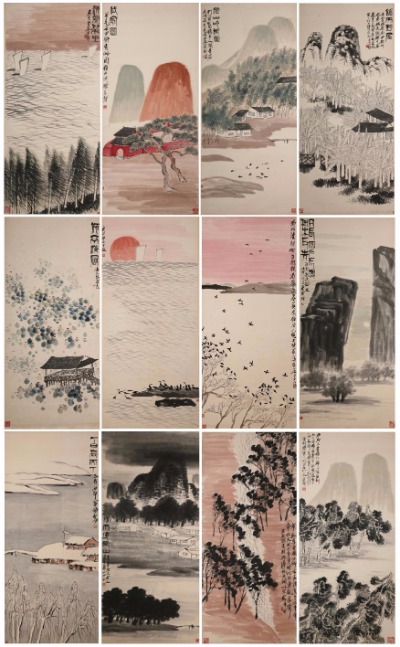 |
|
Qi Baishi's iconic painting, Twelve Screens of Landscapes in Four Seasons, is shown at the Art Museum of the Beijing Fine Art Academy.[Photo provided to China Daily] |
As part of an effort to increase people's understanding of Qi and his art, the Twelve Screens of Landscapes in Four Seasons collection was transported from Chongqing to Beijing, where they are now on show at The Landscape in Mind Surprises the World, an exhibition at the Art Museum of Beijing Fine Art Academy that runs through Sept 23.
Sharing the limelight at this exhibition dedicated to Qi's landscape art are dozens of major works, sketches and drafts from several institutions, such as the Beijing Fine Art Academy, the Palace Museum and the Liaoning Provincial Museum in Shenyang that boast rich collections of Qi's artworks.
The record-breaking sale has ignited people's interest in learning more about Qi, prompting a number of well-curated exhibitions at home and abroad. Besides the exhibition at the Art Museum of the Beijing Fine Art Academy, a show of Qi's art is being held at the Palace Museum through Oct 8.
Wu Hongliang, director of the Art Museum of the Beijing Fine Art Academy, says the museum will exhibit the academy's collection of Qi's works in Liechtenstein and Japan within the year.
Qi became the academy's honorary head when it was established in 1957. He died a few months later and his family donated a number of his works and collections to the academy.
Wu says Qi endeavored in the realm of classic Chinese art - he was adept at painting, calligraphy, poetry and seal carving - and his moves to reject the highly formulated styles popular at the time were "spontaneous with similar movements in Europe in the early 20th century, such as post-impressionism and fauvism".
"I wonder how Qi would feel in the next world," Wu says, joking, "if he knew his works were going places today?"
The master would have felt pleased, as traveling brought significant changes to his landscape works. He undertook five separate journeys across the country between 1902 and 1909, famously known as "five outings and five returns", which inspired him to develop his own individual style.
When Qi set out to visit a friend in the north of China, he was a father of three children, who felt discontented with a potential future as a rural painter in his native Hunan province.